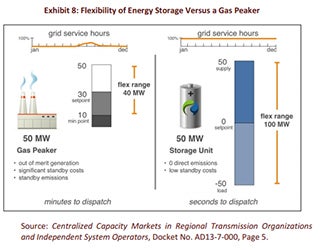Cost-Benefit Analysis of Utility-Scale Energy Storage is Promising
By: Ellen Shea, Analyst, EDF Climate Corps
 I recently read a white paper by Chet Lyons of the Energy Strategies Group performing a cost-benefits analysis of utility companies purchasing battery storage systems vs. simple cycle gas-fired combustion turbines (CT). These CT systems are typically used to regulate peaking capacity. The article shows how storage systems can be a great solution for utilities companies to keep up to date with the changing trends in energy in the US.
I recently read a white paper by Chet Lyons of the Energy Strategies Group performing a cost-benefits analysis of utility companies purchasing battery storage systems vs. simple cycle gas-fired combustion turbines (CT). These CT systems are typically used to regulate peaking capacity. The article shows how storage systems can be a great solution for utilities companies to keep up to date with the changing trends in energy in the US.
Lyons states that as we shift to using more and more renewable energy sources (such as solar PV), the electricity grid needs to be able to be more flexible to the fluctuations in supply of wind, solar, etc. In other words, we have to be able to better support the peaking capacity of the grid.
The paper makes the case for using energy storage systems as a way to meet the peaking resource needs of the grid from renewables, and also as a way for utilities to recoup some lost revenues. Lyons examined a new flow battery storage system by ViZn Energy and found it to be more effective, faster, and more flexible than traditional CTs. Additionally, following solar PV’s trend of declining costs, he believes that in the next three years these battery storage systems will be cost competitive with CTs.
In the paper, the graphic (pictured above) does a good job showing the benefits of battery storage vs. a CT.
There are several challenges Lyons outlines along the way. The biggest one is that currently storage systems are only cost beneficial for “vertical utilities,” meaning those that own generation, transmission, and distribution. Right now, less than half of the US population lives in these vertical utilities markets. The other markets will require policy changes to make it worthwhile for them to consider battery storage.
In summary, Lyons shows that in a few years battery storage will be a realistic solution for utility companies to meet the needs of peak load management for renewable energy resources on the grid, while still providing cost benefits to the utility companies. He also believes the shift to more renewables, combined with using this type of peaking capacity system, will cause a paradigm shift from the way utilities operate to a distributed power grid.
This article does a good job explaining how new technologies can help utility companies keep up with the changes in the energy market, as well as overcome issues related to fluctuating peak capacity and demand.
This post originally appeared on our EDF Climate Corps blog.











2 Comments
re: “The biggest [challenge] is that currently storage systems are only cost beneficial for “vertical utilities,” meaning those that own generation, transmission, and distribution”
Like batteries, our Exergy Storage System (thermal, for heating and cooling) has many benefits:
1) by replacing centralized energy sources (most notably natural gas) with local energy sources
2) by reducing the costs of delivering the energy
3) by making the existing electricity generation more productive
4) by shifting power demand from peak to off-peak periods
5) by reducing the capital expenditures on systems that boost the rate of generation
6) by reducing the costs of dealing with supply interruptions
7) by reducing the GHG consequential costs such as “carbon taxes”
These all accrue to the generators and distributors in the electricity system, not consumers or building owners. Convincing the Generation/Distribution entities (or the regulators) that financing the storage is in their (and the public’s) interest is proving difficult.
Due to the complex nature of generation and distribution, there are a variety of obstacles to selling energy storage systems these days. We were excited to see in this analysis, though, signs that battery storage systems can provide peaking benefits and might become cost-effective and feasible in the next few years, particularly for vertical utilities. Thanks for your comment!